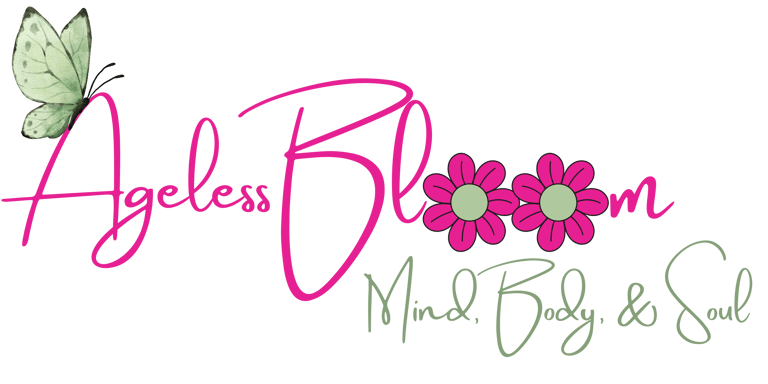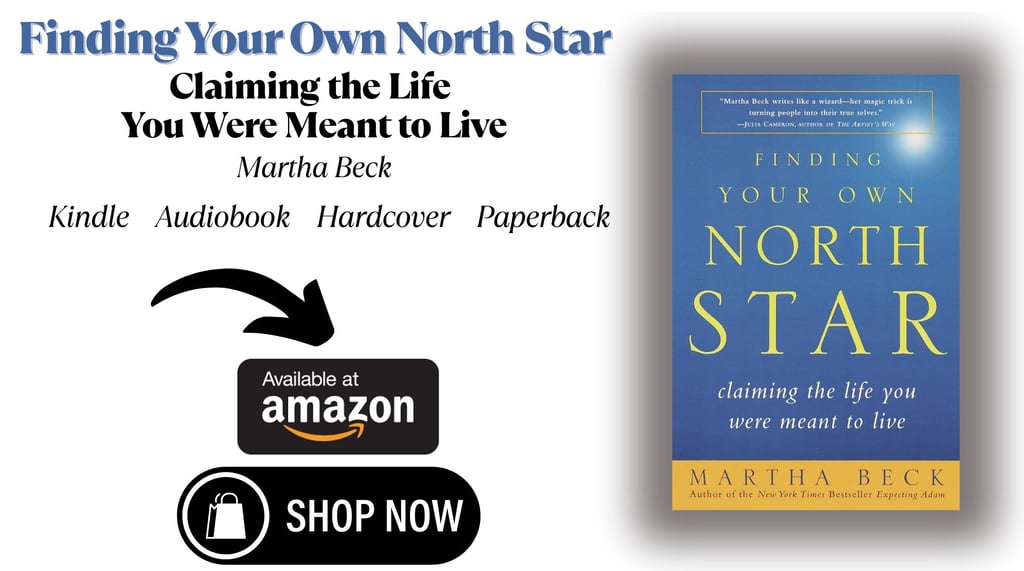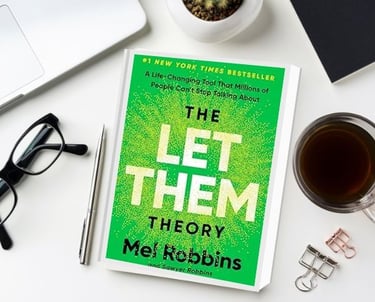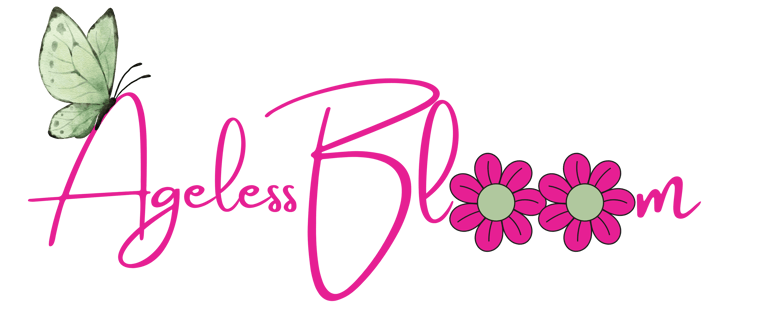Find Your Purpose and Design the Life You Want as a Woman
Find Your Purpose and create the life you want. Learn simple strategies for women to focus on what matters, set goals, and take real steps.
SELF CARE AND PERSONAL GROWTH
Shari Smith
7/12/202515 min read
As an Amazon affiliate, we earn commissions at no extra cost to you if you click our links and make a purchase.


Have you ever paused long enough to ask what truly lights you up? Finding your purpose isn’t just an inspiring idea, it’s the steady force that lets you design a life you actually love waking up to.
For women, tuning in to that deeper sense of direction gives you more than clarity—it opens the door to real confidence and choices that match your hopes, not just your habits.
When you give yourself permission to put your purpose first, daily life starts to feel less like just getting by and more like a path you get to shape.
You’ll discover how this simple shift can help you move from feeling busy and pulled in every direction, to feeling grounded and in control of your own story.
Here’s how you can start to find your purpose and gently shape your world around it, no matter where you’ve been or how messy things feel right now.
Understanding Purpose: What Does It Really Mean?
Living with purpose is about asking with honesty: What am I here for?
It goes deeper than checking boxes or doing what’s expected.
Purpose is the steady pull that gets you through heavy mornings and sticky afternoons.
It shapes how you show up at work, in your home, with friends, or even when you’re alone with your thoughts.


When you find your purpose, you tap into a sense of meaning that travels from your work to your relationships and even shapes your well-being.
Purpose isn’t a to-do list or a single dream. It’s more like the soil everything else grows from. Most women have been told at some point what should matter or what should come first.
Those messages can make you question your own voice and ideas. Straightening out what purpose means for you personally is the first step in designing a life that actually feels like yours.
The Difference Between Goals and Purpose
We hear a lot about goals—write them down, smash them, then chase new ones. But goals and purpose play very different roles in your life.
Goals are checkpoints. They mark your progress and give you something to look forward to.
Purpose is the compass. It shapes which direction you even want to walk in the first place.
Think of goals like signposts along a highway. Reaching them can feel good, but without a real reason behind the drive, you risk ending up somewhere that doesn’t feel right.
Goals can change—maybe a new job, a healthier routine, a bigger network. Purpose, on the other hand, stays with you. It guides your choices and your reactions.
When you find your purpose, your goals start to feel less like chores and more like steps you actually want to take.
When life feels aimless, you might not need more or bigger goals.
You may just need to pause, tune in, and listen for your own sense of meaning—what truly matters to you before you even start planning what comes next.
Why Women Often Lose Sight of Their Purpose
Women carry a quiet weight that isn’t always spoken about. Society, family, and even our closest friends can cast long shadows over our ideas of who we should be.
The world is often quick to lay out the ‘‘right’’ path: be the caring daughter, a loyal partner, or a selfless mother. Somewhere in that shuffle, your own sense of drive can get buried.
There are a few reasons this happens:
Societal pressures: From early on, women are taught to keep peace, care for others, and sometimes shrink their own needs.
Family expectations: You might be encouraged to put family dreams before your own or to choose roles that feel safe or familiar.
Cultural norms: Many cultures push the idea that a woman’s purpose is found in service to others, not in listening to herself.
It’s easy to see how these outside voices become loud enough to drown out your own story. Maybe you’ve felt guilty for wanting something just for you, or you’ve dismissed your own dreams as selfish.
These feelings don’t mean you’re lost—they mean you’re human.
The truth is: Your purpose is yours to define, even if you have to find it piece by piece. Listening to that small, steady voice inside—especially when it’s hard—is a bold move.
You’re not alone in wanting more, or in wondering what’s next. Giving yourself permission to find your purpose is never wasted time. It’s the beginning of building a life that finally feels like home.

How to Find Your Purpose
& Design the Life You Want
Mel Robbins
Watch Video...
How to Find Your Purpose as a Woman
Finding your purpose as a woman can feel like clearing the fog after a long night.
Sometimes your path feels hidden behind old ideas or quieter voices. The truth is, purpose isn’t something you pull out of thin air.
It grows from your lived experience, your struggles, your joys, and the small, steady choices you make every day.
When you’re ready to find your purpose, take gentle steps inward. The journey starts with honest reflection and a little patience with yourself.


Self-Reflection Techniques and Journaling Prompts
You already carry clues within you—memories, strengths, favorite moments, and even regrets. Listening to these parts helps you see your real self, not just the version you’ve presented to fit in.
Try setting aside quiet time, even if it’s just fifteen minutes. It’s about getting curious with yourself, not judgmental.
Here’s how you can start:
List what energizes you: Jot down moments when you lose track of time or feel at ease in your own skin.
Recall what you loved as a child: Sometimes what mattered to you before the world got loud still whispers when you listen.
Notice your strengths: Name easy wins and the tasks that come naturally. Where do friends turn to you for advice or encouragement?
Identify moments of real connection: When did you last feel seen or useful? What were you doing and who were you with?
You can use prompts like:
When do I feel most alive and in tune with myself?
What can’t I stop talking about or thinking about?
How have my struggles shaped what I care about?
Who in my life do I admire, and why? What do our stories share?
If fear weren’t part of the equation, what would I choose to do next?
Write freely. No one has to read this but you. Over time, you’ll see patterns: recurring values, passions, problems you want to solve, or ways you want to help.
They point toward your purpose, waiting for you to claim them.
Identifying Limiting Beliefs and Overcoming Doubt
Sometimes, you feel ready for change but something invisible ties you to the spot. These are your limiting beliefs—the quiet “I can’t” or “I’m not enough” that run on a loop in the background.
They can come from old wounds, well-meaning advice, or social pressure. Learning to find your purpose means naming what’s holding you back and calling it out.
Here are a few types of limiting beliefs women often carry:
I’m too old or too late to start.
My dreams are selfish.
I need everyone’s approval before I act.
I’m not as smart or talented as others.
Start spotting these thoughts in daily life. The next time doubt crops up, don’t shoo it away; write it down.
Ask yourself:
Is this voice actually mine, or did I learn it from someone else?
What past experience shaped this belief?
How true is this thought really—have I ever proven it wrong, even a little?
To start shifting your mindset, try:
Reframe the story: Instead of “I’m not ready,” try “I’m learning as I go, and that’s enough right now.”
Evidence gathering: Make a list of small wins, even if they seem tiny. Every step counts.
Positive self-talk: Talk to yourself like you would a close friend. Be gentle. Remind yourself of your progress.
Affirmations: Choose words that ring true for you, like “I am allowed to put my dreams first,” and repeat them daily, even if you feel silly at first.
Seek supportive voices: Surround yourself, in real life or online, with people and stories that remind you what’s possible.
Nobody is immune to doubt, but you don’t have to let it steer your choices. When you shed beliefs that shrink you, you make room for purpose to grow.
You become both softer and braver, ready to choose your path with your whole self—quirks, scars, and all.
Designing the Life You Want: Putting Purpose into Action
Once you begin to find your purpose, the next step is weaving that sense of meaning into your day-to-day life.
It’s one thing to feel inspired for a moment—a whole other to hold onto that feeling when life pulls you off track.
Lasting change happens when your decisions, habits, and environment begin to reflect the person you want to become.
Here’s how to move from insight to action, and build daily routines that echo your true direction.


Creating a Personal Vision Statement:
A personal vision statement brings clarity to your hopes and drives. It isn’t just a handful of words written for show. Instead, think of it as your North Star—a guide you can return to when you need steadiness and focus.
Here’s how you can create your own, no matter where you are in life:
Reflect on Your Values Write down what matters most. Is it creativity, family, growth, freedom, kindness, or security? Your values are the roots that keep your life steady when the wind picks up.
Picture Your Ideal Day Close your eyes and picture a day that feels perfect to you. Where are you? Who are you with? What are you doing? How do you feel? Let this vision be simple or bold—nothing is off limits.
Honor Your Stage of Life Are you building a career, caring for young children, adjusting to an empty nest, or savoring a new season? Your vision can change with you. Trust that it’s right to want different things at each stage.
Capture Your Why Ask yourself why you want these things. Is it more space for joy? Deeper relationships? Time for your own passions? Your “why” brings heart to your vision.
Write It in the Present Tense Keep it short and simple. For example:
“I am a source of support and laughter for my family, and I make time each day for my art.”
“I nurture my mind and body with simple habits, and I surround myself with people who lift me up.”
“I use my unique voice to amplify stories that matter, and I set steady boundaries around my needs.” Writing your statement as if it’s already true helps your brain believe it can be real.
Review and Adjust Regularly Let your vision grow and shift over time. Check in with it every few months, and adjust as your life changes.
A well-crafted personal vision statement gives you something to hold onto during rough days. It steers you back to purpose when life gets loud and messy.
Aligning Your Life with Your Purpose:
Once you have your vision, the real work begins—turning words into action. This is where you start making real-life choices that echo your purpose. That can feel a little scary, but it’s also where the satisfaction grows.
Try these tactics to live in line with your purpose every day:
Pause Before Saying Yes Not every good thing fits the life you want. Before committing, ask yourself, “Does this line up with my purpose or pull me off course?” Simple check-ins help you make stronger choices.
Set Gentle Boundaries Boundaries are not walls—they are fences with gates you control. They protect your time, energy, and joy. Maybe it means saying no to an extra volunteer task, or asking for help at home so you have space for your own goals.
Build Your Day Around Purposeful Habits Even tiny habits keep you close to what matters. If connection is key, plan a regular coffee with a friend. If creativity lights you up, block out a half hour to write or draw each morning.
Seek Out Opportunities That Fit When a new offer or idea pops up, weigh it against your personal vision. Ask, “Does this help me grow in the direction I care about?” Let your purpose become the standard you measure by.
Share Your Vision With Trusted People Tell someone you trust about your purpose and what you’re working toward. Their encouragement keeps you going, and your honesty might even inspire them in turn.
Forgive Yourself for Off Days Living with purpose is a practice, not a perfect scorecard. Some days you’ll miss the mark, or get knocked off track. That’s when it matters most to be gentle with yourself and start fresh again tomorrow.
Bringing purpose into your daily life won’t always feel easy or comfortable. But each small step is a signal to yourself—and the world—that your life belongs to you.
With steady practice, you’ll start to see your days, and then your years, reflect the real, grounded purpose you’ve been searching for.them.
Designing the Overcoming Obstacles on the Path to Purpose
Finding your purpose can feel like finding a small light in the middle of a cloudy day.
You know it’s there, but sometimes clouds roll in—old fears, outside opinions, or moments when things just fall apart.
Every woman faces roadblocks, both inside her own mind and out in the world. What matters most is how you respond.
Learning to meet these hurdles with honesty and care is how you build a life that feels right for you.


Handling Fear, Criticism, and Setbacks
Fear, criticism, and setbacks almost always show up when you try to change your life. It doesn’t mean you’re on the wrong path; it just means you’re moving forward.
Fear often pops up first. Maybe you’re worried about disappointing someone, or you doubt your own ideas. Sometimes it feels easier to stay quiet than to risk failing.
Here are some gentle ways to handle fear of failure and negativity when you’re ready to find your purpose:
Name the fear out loud. The simple act of saying, “I’m scared” gives it less power. Write it down, share it with a friend, or say it in the mirror.
Break big goals into tiny pieces. It’s less scary to take one small step than to leap all at once. Every little win helps.
Let criticism be a tool, not a weight. Not every opinion about you is rooted in truth or kindness. Listen for what’s useful, and leave the rest. Ask yourself if the critique is about your growth, or someone else’s comfort zone.
Give yourself credit for trying. You learn each time you get back up. Mistakes are proof that you’re taking action, not just wishing.
Remember, setbacks are the pause, not the end. Everyone falls short now and then. Use it as a chance to breathe, learn, and choose a new next step.
When old stories in your head whisper, “You can’t,” remind yourself you’re allowed to write a new story. The path to purpose is a string of tries, missteps, and gentle do-overs.
About the Let Them Theory Book
The Let Them Theory book was created as a guide for these very moments. Inside, you’ll find:
Simple ways to stop giving your power away to others’ choices and the world’s chaos
Practical steps for managing your emotions, even when it feels impossible
Insights from neuroscience on stress, control, and change
Guidance for handling relationships, especially with people who challenge your peace
You can grab your copy in hardcover, audiobook, or Kindle formats at Amazon.
The Importance of Support Systems
No one is meant to do this alone. Having people who believe in you—even when you’re doubting yourself—can turn a hard day into a chance to keep going.
Support is not about having perfect advice; it’s about feeling seen and cheered on.
Here’s how you can build or deepen your circle while you find your purpose:
Look for mentors—someone who’s walked a similar road, or simply listens with wisdom. It could be a teacher, an older friend, even someone you follow online who makes you feel understood.
Lean into friendships that lift you up. Spend more time with people who support your dreams, rather than those who nudge you back to comfort zones.
Join communities or groups. Whether online or in person, look for spaces where women talk about growth, dreams, and challenges. Sometimes a forum, a book club, or a faith group can be a lifeline.
Ask for help. Reach out when you need advice or a listening ear. Let people know what you’re working toward—chances are, someone wants to cheer for you.
Celebrate small wins together. Sharing progress, no matter how tiny, builds hope. It also helps others open up about their own hopes.
Think of your support system as the soil that helps your purpose root and flourish. If you don’t have that kind of circle right now, it’s okay to start small.
Even one trusted person makes all the difference. When you honor your need for connection, you lay the groundwork for the kind of life you really want.
Living Purposefully Every Day
Building a meaningful life isn’t just about what you dream up on big birthdays or during quiet retreats.
The heart of purpose reveals itself in the ordinary hours—making breakfast, running errands, caring for family, and deciding how to spend each quiet moment after.
If you want to find your purpose and truly design the life you crave, it helps to anchor yourself with small, gentle routines.
Day by day you gather a sense of clarity and comfort, even when life feels messy or uncertain.


Mindfulness and the Role of Gratitude:
Mindfulness is a practice that calls you back to yourself, especially on days when your schedule and feelings seem scattered.
Think of it as a gentle pause—an invitation to check in with your deeper hopes, not just your to-do list. When you combine this with gratitude, you start turning even challenging days into proof of your own growth.
Here are some daily grounding habits that can keep your sense of purpose close:
Begin your morning with intention. Before you reach for your phone, take a minute to ask, “How do I want to show up today?” This simple question centers your day.
Practice gratitude in small moments. At breakfast or bedtime, jot down three things you’re thankful for. These can be as simple as the warmth of sun through the window or a few minutes of quiet before the day begins.
Check in with your values. Pause between tasks and ask yourself, “Is what I’m doing right now aligned with what matters most to me?” If not, gently reset without guilt.
Use mindful breathing. When you feel overwhelmed, slow down and take three deep breaths. Place your hand on your heart as you breathe. This small act connects you back to your core.
Create reminders of your purpose. Write a short mantra or your vision statement on a sticky note where you’ll see it—on your bathroom mirror or beside your workspace.
Making gratitude and mindfulness a steady part of your routine helps you stay rooted in what’s true for you—not just swept along by everyone else’s plans.
Over time, these small practices add up, turning ordinary days into stepping stones that help you find your purpose again and again.
Celebrating Your Progress and Impact:
Many women are quick to downplay their wins or brush off the ripple effect of their choices. But every little step forward—is worth celebrating. Acknowledging progress gives you fuel, keeps up your hope, and opens your eyes to how living by purpose influences others around you.
Consider these ways to notice your growth and inspire those connected to you:
Mark even the smallest milestones. Did you journal for a week straight? Say no when you usually would have said yes? Take a moment to savor it. Light a candle, share it with a friend, or speak gratitude out loud.
Keep a progress log. Record your wins (tiny or big) in a dedicated journal or notes app. Flip through it when you start to doubt your direction.
Share your story. Open up to a trusted friend or group about what you’re working toward and how far you’ve come, even if you’re still in the messy middle.
Acknowledge how you influence others. Maybe your children see you try something brave, or a coworker notices your new boundaries. You may never know the effect your honesty and effort have on someone else’s journey to find their purpose.
Celebrate with others. Surprise a friend by cheering on her progress, or start a small group where you swap stories and hold each other up.
Living purposefully doesn’t mean being perfect. It means noticing the steps, the stumbles, and everything in between. Every time you pause to celebrate or encourage another woman, you help grow a community built on kindness and real progress.
Over the years, these acts create a sense of belonging and boost motivation, helping you return to your purpose whenever life pulls you off course.
You deserve to see, welcome, and cherish every sign of your own growth. Put these small rituals in place, and watch how gratitude and celebration transform everyday living into a life that feels unmistakably yours.
Conclusion
Finding your purpose is not a finish line, but a part of your daily life. The steps you take today—whether they’re small shifts in your morning routine or bigger choices about who you let close—help shape the life you want tomorrow.
When you honor what lights you up and give yourself space to try, learn, and begin again, you create real change that lasts.
Let your story grow at its own pace. Keep listening to your needs, celebrating your steps, and reaching for support when you need it.
Your life belongs to you, and every honest effort to find your purpose shapes it into something rich and lasting.






